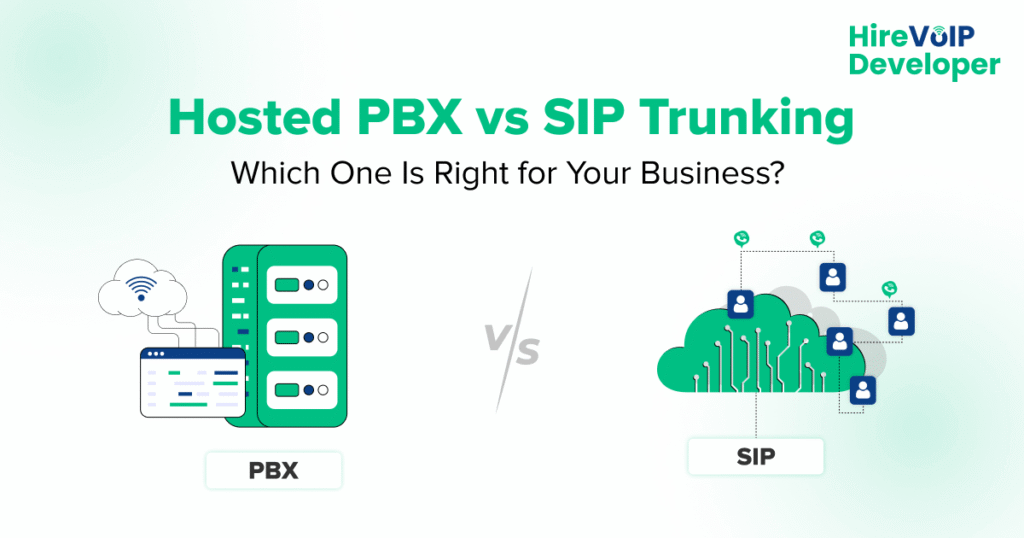Every call center faces exceptional challenges, such as uninterrupted communication, peak call volume management, and maintaining quality service interactions. But before achieving any of the tasks outlined, you must make one crucial decision: Is PBX SIP Trunking or custom-hosted PBX solutions the most suitable option for your call center?
Both solutions have gained popularity in VoIP due to their cost-effective features, flexibility, and scalability. Considered together, each fulfills different purposes and caters to various business models. Hence, let’s join hands and analyze the advantages and disadvantages of each, along with their practical use, so that you can make a better decision.
What Does SIP Trunking Mean for Call Centers?
SIP trunking replaces traditional phone lines (PSTN). Instead, it connects the call center’s on-premises PBX system to the Internet via an SIP provider. SIP trunking enables voice, video, and messaging over the Internet.
How SIP Trunking Works?
Your PBX system initiates a call. The SIP trunk PBX takes the call information and transmits it online. This option is the most effective for call centers that keep their PBX system on-site and want to move away from the expensive legacy PSTN lines.
What is Meant by Hosted PBX for Call Centers?
A service provider oversees the provided solution and the telecommunication system architecture for hosted PBXs (Private Branch Exchanges), which are accessible via the cloud. System support and security include services, and the administrator can control user extensions via an online interface.
How Does Hosted PBX Work?
During communication, call traffic takes advantage of the cloud-based system’s infrastructure.
The service provider is responsible for the advanced voicemail and call routing features.
VoIP phones or softphones allow users to place calls easily from anywhere. They do not require an on-site physical setup, making them a cost-effective solution when implementing remote or hybrid call centers.
SIP Trunking vs Hosted PBX for Call Centers
Even though these options enhance call center communication, the primary distinction lies in how you host and control the system. Here’s a thorough analysis to assist you in making a choice.
Hosted PBX vs SIP Trunking
|
Feature |
SIP Trunking |
Hosted PBX |
|
Infrastructure |
Uses on-premises PBX |
Cloud-hosted, no hardware needed |
|
Scalability |
High, but requires PBX upgrade |
Seamless, managed by provider |
|
Cost |
Lower operational costs |
Monthly subscription model |
|
Security |
Higher control over security |
Provider-managed security |
|
Maintenance |
Requires in-house IT support |
Handled by the provider |
|
Flexibility |
Ideal for hybrid models |
Best for fully remote setups |
|
Call Quality |
Depends on internet bandwidth |
Consistently high in good networks |
|
Customization |
High, can integrate with CRMs |
Limited to provider’s features |
Benefits of SIP Trunk PBX for Call Centers
SIP Trunk PBX offers compelling benefits if you already have an on-premises PBX and want to transition to IP-based telephony. Let’s look at some of the benefits of SIP trunking
- Cost Savings with SIP Trunk PBX
SIP Trunking drastically reduces communication costs by eliminating traditional phone lines. Instead of maintaining separate voice and data networks, you consolidate them into one.
- Lower long-distance and international call rates
- No hardware investment if you already have PBX systems
- Pay-per-channel model ensures flexible pricing
- Better Call Quality and Reliability
With SIP Trunking for call centers, you can ensure superior voice quality by prioritizing VoIP traffic over your network. Additionally, you can implement failover strategies such as automatically rerouting calls in case of internet failure.
- Smooth Integration with Analytics and CRM
Integrating SIP Trunks with your CRM, call recording, and analytics tools is simpler because they are compatible with your current PBX system. For improved customer service, they make data-driven decision-making and real-time monitoring possible.
- High Scalability for Growing Call Centers
Using SIP to scale Trunking is simple and increases the number of channels without changing your PBX setup. SIP can manage demand regardless of how many calls you receive or how big your staff gets.
SIP Trunk PBX reduces costs and enhances call quality, ensuring scalability and data-driven decision-making as your call center grows.
Benefits of Hosted PBX for Call Centers
Hosted PBX provides several benefits if you want to update your call center operations without managing complicated equipment.
- Minimal Maintenance and Setup Costs
Hosted PBX for call centers eliminates the cost of maintaining PBX hardware. The provider manages everything, including system upgrades, patching, and troubleshooting.
- No need for IT staff to manage PBX hardware
- Monthly subscription model with predictable costs
- No capital expenditure for hardware setup
- Flexibility for Remote and Hybrid Teams
Hosted PBX allows your agents to work from anywhere using softphones or IP phones. Since all call routing happens in the cloud, it’s an ideal choice for remote and hybrid call center models.
- Advanced Call Management Features
Most hosted PBX solutions for call centers offer enterprise-grade features such as:
- Auto-attendant and IVR
- Call forwarding and queuing
- Real-time call analytics
- Voicemail-to-email functionality
- Quick Scalability and Adaptability
With hosted PBX, scaling up or down is effortless. The provider manages the system from the cloud, allowing you to add new features, extensions, and even locations without requiring extra hardware updates.
By combining minimal maintenance, advanced features, and seamless scalability, hosted PBX empowers your call center to deliver exceptional customer experiences.
Which Option would help your Call Center the most?
The choice between SIP trunking vs hosted PBX for call centers depends on your specific operational needs, growth plans, and technical capabilities.
Choose SIP Trunking If:
- You have an existing PBX system and want to reduce operational costs.
- You need seamless integration with CRM, call analytics, and third-party software.
- Your in-house IT team can handle PBX maintenance and system upgrades.
Choose Hosted PBX If:
- You prefer a cloud-based, fully managed communication system.
- Your team works remotely or follows a hybrid work model.
- You want a predictable subscription-based pricing model.
Security Considerations for Call Centers
Whether you choose hosted PBX or SIP telecommunications, security should always come first.
SIP Trunking Security
- Use strong encryption (SRTP and TLS) to safeguard private call information.
- To stop unwanted access, turn on multi-factor authentication (MFA).
- Monitor traffic for unusual patterns to detect potential security breaches.
Hosted PBX Security
- Ensure the provider follows industry compliance standards (PCI DSS, HIPAA).
- Use VPNs and secure authentication protocols for remote agent connections.
- Regularly audit access controls and user permissions to prevent data leaks.
Cost Comparison
Initial Setup Costs
- SIP Trunking: High if you don’t have an existing PBX system.
- Hosted PBX: Low, as there’s no need for hardware installation.
Ongoing Maintenance Costs
- SIP Trunking: Higher requires in-house IT expertise.
- Hosted PBX: Minimal, as the provider manages system updates.
Long-Term Savings
- SIP Trunking: Lower per-channel costs, better ROI for high call volumes.
- Hosted PBX: Predictable monthly costs with zero maintenance overhead.
Real-World Use Cases
Use Case for SIP Trunking
SIP Trunking is advantageous for a sizable call center with more than 200 agents that depends on sophisticated CRM and call analytics. Its smooth integration with their PBX allows for more control over security and affordable scalability.
Use Case for Hosted PBX
Hosted PBX gives agents safe access from any location in a mid-sized call center with fifty remote agents. The cloud-based infrastructure allows for rapid feature rollouts and less maintenance.
Future Trends: Hosted PBX and SIP Trunking in 2025 and Later
Hybrid architectures that combine hosted PBX and SIP telecommunications are the way of the future for call center communication.
- AI-powered call routing will further enhance customer interactions.
- 5G adoption will improve VoIP quality and reduce latency.
- UCaaS will consolidate both SIP and PBX functionalities onto a single platform.
Which One Wins the Hosted PBX or SIP Trunking?
Your call center’s size, expansion plan, and infrastructure preferences will determine which PBX SIP trunking, and Hosted PBX is best for you.
SIP Trunking is your best option if cost-effectiveness, scalability, and control are important considerations. Choose hosted PBX if you value ease of use, adaptability, and low maintenance.
Are you still not sure which is best for you? Before deciding, consider your budget, growth goals, and existing infrastructure. With the appropriate VoIP solution, your call center can provide outstanding customer service in either case.
- Hosted PBX vs SIP Trunking: Best Fit for Your Business
- Discover the key differences between hosted PBX and SIP trunking to choose the best solution for your business communication and call center scalability.
- Hosted PBX, SIP Trunking, Call, VoIP, VoIP Solutions
Related posts:
 High-Quality Biomedical Waste Incinerators & Laboratory Glassware Made in India
High-Quality Biomedical Waste Incinerators & Laboratory Glassware Made in India
 Understanding the Role of IoT in Modern Manufacturing: A Comprehensive Guide to Smart Factories and Industrial Transformation
Understanding the Role of IoT in Modern Manufacturing: A Comprehensive Guide to Smart Factories and Industrial Transformation
 Best Account Management Software for All Businesses – EmizenTech
Best Account Management Software for All Businesses – EmizenTech
 The Role of an ATS in Onboarding: Bridging the Gap Between Offer and Start Date
The Role of an ATS in Onboarding: Bridging the Gap Between Offer and Start Date
 Benefits of AI-powered CCTV Cameras for Business Surveillance
Benefits of AI-powered CCTV Cameras for Business Surveillance
 Top App Development Agency UK – Transforming Ideas into Apps
Top App Development Agency UK – Transforming Ideas into Apps
 Solar Power Exford: New Light with Sunshine Restoration Installation Exford
Solar Power Exford: New Light with Sunshine Restoration Installation Exford
 How Modern Cars Are Turning to Tech Experts to Solve Connectivity Chaos
How Modern Cars Are Turning to Tech Experts to Solve Connectivity Chaos







